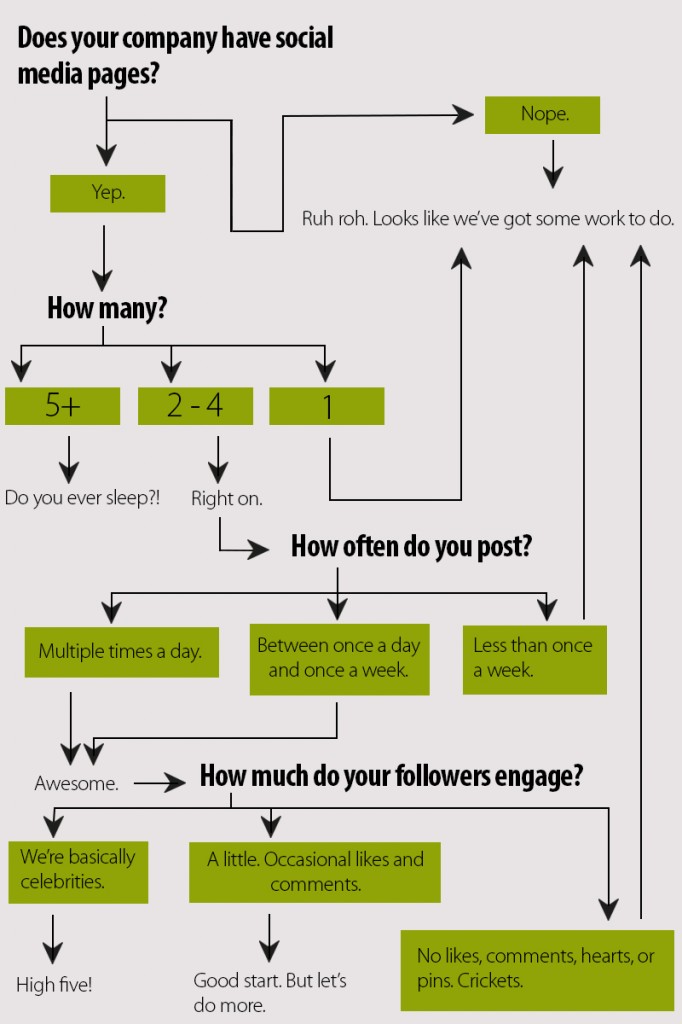How to Create a Vision for Your Social Media Presence
Planning is the key to a successful social media strategy. That may seem like a no-brainer, but what about the step that comes before planning? Planning is important, but a company vision is the key to a successful plan. Don’t worry; we don’t mean a vision like those late-night commercials for phony psychics. We mean a vision in its truest sense: the ability to see.
Before you start a strategic plan for your company’s social media strategy, you should be able to see, analyze, and understand who you are as a business. If you don’t have a clear starting point and an equally clear destination, your company will struggle to succeed at social media and your efforts will take twice as much time and energy. Not to mention: how will you ever know once you’ve reached success? You can’t reach Point B unless you know where Point A is. Time to do some soul searching. To create a vision for your social media presence, think through these three questions:
Where are you now?
Take an (honest) look at your company and your social media strategy as it stands now. 
Where do you want to be? How will you get there?
Once you figure out where you stand, look forward and determine how you want your social media pages to improve. I’ve found that it’s best to separate your goals into two categories: short term and long term.
Short Term:
1) Determine which platforms you’ll use.
First thing’s first: choose the social media communities that you want your business to engage with. Each social media platform has its own distinct demographic and atmosphere; choose which ones best suit your brand. What kind of content do you want to produce? Facebook and Twitter are great for promoting text content while Pinterest, Instagram, and YouTube are better for visual content. You should have a mix of both. You should also think about who your audience is and where they reside online. Facebook is more popular among older buyers, while younger clients might use Twitter more frequently.
2) Research your competitors.
After you choose your social media platforms, scan each of them for your competitors. What are they doing? Do they have good or poor engagement from their followers? Make a note of which strategies work for them and which strategies you can use to your advantage.
3) Begin growing your fanbase.
Target your audience, and build a community. The rules for gaining followers change from platform to platform, so make sure you play by the rules on each account to keep your page from being flagged. For instance, make sure you create a business page – not a personal account – for your company on Facebook. You can then post content and begin encouraging your fans to share your posts.
On Twitter, you can search for terms like “real estate [your town]” or “[your town]” to find people near you. Follow them, and start interacting with them. In turn, optimize your own page with keywords like “real estate” so that people can find you when they conduct their own searches. In case you need a refresher on how to use Twitter for your business, check out our free ebook on how to use Twitter in the real estate world.
These techniques help you to build a targeted community for your business. You can also leverage social media ads to put your brand in front of an even larger community.
4) Find industry thought leaders.
Just like searching for potential clients online, you can also search for experts in your field. These experts will provide you with valuable content that you can share with your followers. If you’re in real estate, consider following pages like Inman News (@InmanNews) to help grow your social media pages.
Long Term:
1) Build consistent messaging.
What is the founding message of your company? What do you want your clients to know about you? If you’re an agent that wants to be known as an expert in land transactions, consider building your social media posts around questions and news concerning land transactions in your region. One of our clients, Better Homes and Gardens Real Estate: The Shanahan Group, does a great job of creating consistent and focused messaging on their Facebook page.
2) Discover ways to recycle content across all platforms.
Carry content from your website (like ebooks) to your social media page. This content provides value to your followers and also encourages them to visit your company’s website. You can also create specific pages on Facebook to market products like your blog or a set of ebooks. Not sure how to write killer website content that will perform on social media? We’ve got you covered here.
3) Publish, test, repeat.
Once you have a few solid social media posts under your belt, figure out what resonates best with your audience. Platforms like Facebook and Pinterest have analytic features that observe and document how people engage with your posts. Do you get more likes and views on posts with pictures? Posts that use humor? Once you find your best content, continue to use the same strategies to build more engagement for your brand.
Every successful social media strategy requires a bit of trial and error to finesse. Be patient with yourself and your company, stay diligent with your posts, and watch the ROI on your social media accounts rise. Curious to learn more about digital marketing strategies for real estate to elevate your business? Contact us today for specific recommendations for your business.









